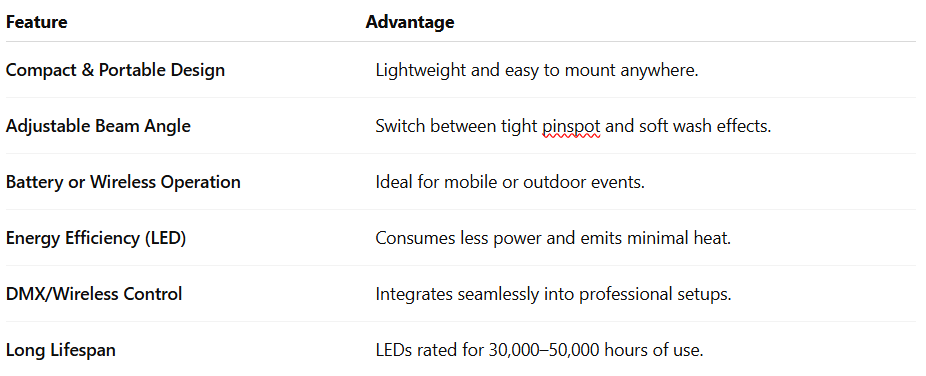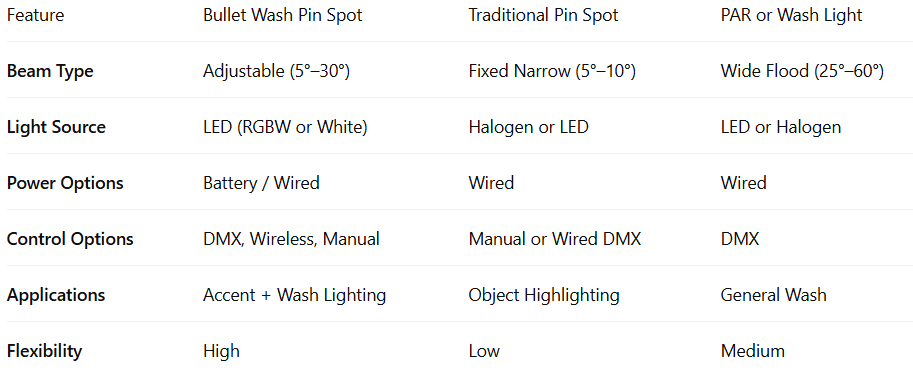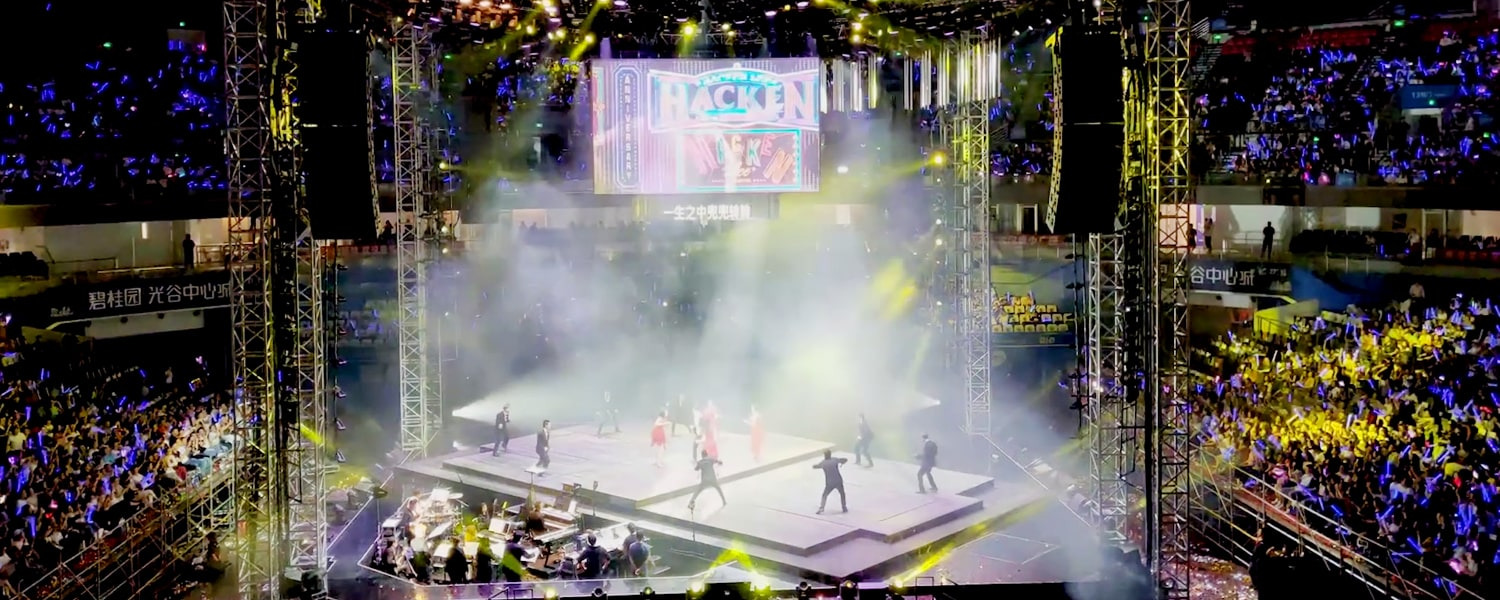In modern event and hospitality lighting, precision and adaptability matter more than ever. Designers want a fixture that can both highlight small details and create soft, atmospheric washes. That’s where the bullet wash pin spot light comes in.
You may have also heard professionals refer to it as a bullet zoom pinspot light a compact yet powerful fixture capable of both narrow-beam spotlighting and wide wash illumination. In this article, we’ll explore what it is, how it works, and why it’s become an essential tool for lighting designers and event professionals worldwide.
What Is a Bullet Wash Pin Spot Light?
A bullet wash pin spot light is a specialized LED fixture designed for focused accent lighting and broad wash coverage in one compact housing.
The term “bullet” refers to the cylindrical, elongated shape of the fixture — designed for sleek mounting and discreet placement. “Wash” indicates its ability to produce a wide, soft beam for general illumination, while “pin spot” refers to the tight, concentrated light ideal for highlighting specific areas like floral arrangements, artwork, or tables.
In essence, this hybrid light combines precision pinspot functionality with wash coverage versatility, allowing event professionals to illuminate both focal points and background ambience without swapping fixtures.
How Does a Bullet Wash Pin Spot Light Work?
The working mechanism of a bullet wash pin spot light relies on LED technology, optical control, and beam adjustment. Below is a simplified breakdown of its components and process.
1. LED Light Source
At its core lies a high-intensity LED chip or diode that produces clean, bright light with minimal heat emission and high energy efficiency. Most models use 3W–10W LEDs with lumen outputs ranging between 300–800 lumens, ensuring sufficient brightness for event environments.
2. Optical Lens and Beam Angle
The optical system — typically consisting of a reflector and focusing lens — shapes the beam into a narrow or wide spread.
- Pinspot Mode: ~5°–10° beam angle for tight, focused illumination.
- Wash Mode: 20°–30° beam for softer, broader coverage.
- Advanced models include zoom or focus-adjustable lenses, letting users shift from pinpoint accuracy to wash effect dynamically.
3. Power and Control System
Bullet wash pin spots come in two power configurations:
- Wired: Connected via AC power or DMX control lines.
- Battery-operated: Rechargeable units lasting 6–10 hours, ideal for mobile event setups.
Control options may include:
- Manual switch or dimmer knob
- Wireless remote
- DMX512 protocol for professional lighting consoles
- Bluetooth or app-based control in newer models
4. Housing and Mounting
Most fixtures use aluminum or steel housings for durability and heat dissipation.
They often include magnetic bases, clamp mounts, or threaded brackets, enabling quick placement on trusses, tables, or ceilings.
5. Color Temperature and CRI
Many bullet wash pin spot lights offer variable color temperatures (from 2700K warm white to 6000K cool white) or RGBW color mixing for dynamic mood lighting.
A CRI (Color Rendering Index) of 90+ ensures accurate color representation — crucial for décor and stage design.
Applications and Use Cases
Event lighting professionals use bullet wash pin spot lights for diverse scenarios because of their precision, flexibility, and portability. Common applications include:
- Table Centerpieces: Highlighting floral arrangements or table settings.
- Backdrop and Stage Accents: Focused illumination for visual depth.
- Retail Displays: Spotlighting products with minimal glare.
- Wedding & Hospitality Lighting: Soft ambient washes for outdoor or tent setups.
- Bar and Club Lighting: Creating defined beams or subtle glows for ambience.
Their battery operation and wireless control make them especially popular for venues where cabling is impractical or unsightly.
Key Advantages of Bullet Wash Pin Spot Lights

For lighting companies, this means fewer fixture types, simpler logistics, and faster setup times — all while delivering professional-grade lighting results.
Comparison: Bullet Pin Spot vs Other Lighting Types

The bullet zoom pinspot variation further enhances flexibility by offering motorized zoom or manual lens adjustment, ideal for multi-purpose events and theatrical productions.
Maintenance and Durability
To ensure consistent performance, follow these care recommendations:
- Lens Cleaning: Use a microfiber cloth and non-abrasive cleaner after each event.
- Battery Care: Fully charge before use and avoid long-term discharge.
- Storage: Keep in dry, cool environments; avoid humidity exposure.
- Housing Check: Inspect for dust accumulation or heat damage regularly.
Most professional-grade models feature IP-rated enclosures (IP54–IP65) for dust and splash protection, making them suitable for outdoor events.
Why Professionals Prefer Bullet Wash Pin Spot Lights
- Time-efficient setups — quick magnetic or clamp mounting.
- Versatile applications — adaptable for both décor and performance lighting.
- Professional finish — eliminates shadows and enhances color vibrancy.
- Sustainability — low energy consumption reduces operational costs.
From wedding planners to concert lighting technicians, this hybrid fixture offers maximum flexibility with minimal effort
Conclusion
The bullet wash pin spot light represents a new standard in event and architectural lighting — compact, controllable, and brilliantly efficient. By combining pinpoint accuracy with wash versatility, it bridges the gap between function and creativity.
Whether you’re designing a wedding ambience, an art exhibit, or a dynamic event stage, a bullet zoom pinspot light delivers professional precision in the palm of your hand.
Frequently Asked Questions (FAQs)
1. What makes a bullet wash pin spot light different from a regular pinspot?
A bullet wash pin spot combines the narrow beam of a pinspot with the broader output of a wash light, offering dual functionality in one fixture.
2. Can bullet pinspots be used outdoors?
Yes, most professional units have IP-rated housings (IP54–IP65) for weather resistance, suitable for outdoor setups.
3. How do you control color or brightness in a bullet pinspot?
Through DMX, wireless remote, or app-based control systems depending on the model.
4. What is the beam angle range of a bullet zoom pinspot light?
Typically adjustable between 5° and 30°, depending on lens type.
5. Are battery-operated bullet pinspots reliable for long events?
Yes. High-capacity lithium-ion batteries provide 6–10 hours of continuous operation on full charge.
6. How many pinspots are needed to light a 6-foot table?
Generally, one fixture is sufficient for a standard round table, but two may be used for even illumination from opposite angles.
7. What is the typical lifespan of an LED bullet pin spot light?
LED modules last approximately 30,000–50,000 hours, depending on usage and maintenance.

